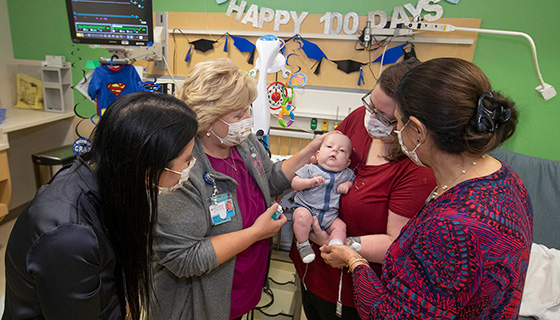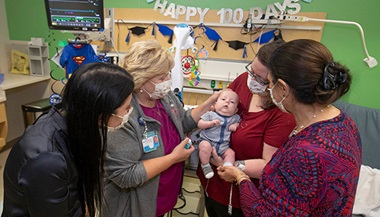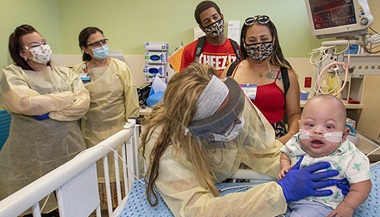Circumcision
Circumcision is the surgical removal of the foreskin that covers the tip of the penis. It is usually done on the first or second day after the baby’s birth. Circumcision can be done on older children and adults, but this can be more complicated because it needs general anesthesia.
Circumcision is a relatively simple procedure that is done in the hospital and has few complications. Although there has been some debate in recent years over whether a circumcision is medically necessary and whether it provides any health benefits, the general agreement among healthcare providers is that benefits outweigh risks for the procedure.
Why should I consider circumcision for my baby?
Most people decide to circumcise their baby boys for cultural or religious reasons. Others believe that there are health benefits to having the foreskin of the penis removed, such as:
-
Prevention of urinary tract infections in infants
-
Prevention of penile cancer in adult men
-
Reduced risk of developing certain sexually transmitted diseases
-
Reduced risk of developing cervical cancer in female sexual partners
-
Reduced risk of developing penis infection and swelling
The prevention of urinary tract infections in infants is the most widely accepted benefit for the procedure.
What are the risks of the procedure?
Circumcision does have some risks, but the rate of complications is low. The most common side effects are bleeding and infection.
The skin of the penis is also quite sensitive after a circumcision. Sometimes, the area can get irritated from contact with the baby’s diaper or with the ammonia in urine. Usually, these small problems can be treated by applying petroleum jelly with diaper changes for a few days. They will resolve on their own after a few days.
There may be other risks, depending on your baby’s health. Be sure to discuss any concerns with your healthcare provider before the procedure.
How do I prepare for the procedure?
-
Because circumcision is often done 1 to 2 days after birth, you’ll want to make the decision well before your baby is born.
-
Make sure your healthcare provider fully explains the procedure, so you are comfortable with it.
-
If your baby is born prematurely or has other medical concerns, he may not be circumcised until he is ready to leave the hospital.
-
If your baby has a physical abnormality of the penis, he may not be circumcised at all. Often, this foreskin is used in a future surgical procedure.
-
Not everyone uses anesthetic for a circumcision. The American Academy of Pediatrics recommends it.
What happens during the procedure?
If you decide to have your baby circumcised, the procedure is usually done in the hospital. These are the typical steps in a circumcision:
-
Your baby will be taken to a special surgical area and any clothing will be removed for the procedure.
-
The baby will likely be placed in a restraining device. This will keep him from wiggling around or moving during the procedure.
-
The healthcare provider may give your baby a pacifier dipped in sugar water to soothe him while the procedure is happening.
-
The healthcare provider will usually give your baby 1 of 2 types of local anesthesia. Choices are a topical cream that numbs the penis or an injected anesthetic that works much more quickly.
-
The healthcare provider will next prepare the penis by applying an antiseptic.
-
In some cases, the healthcare provider will place a surgical drape over the baby with just the penis exposed. This will help keep the area sterile (free of germs) during the procedure.
-
The healthcare provider may attach a plastic clamp or ring to the penis to make it easier to cut the foreskin.
-
Now the healthcare provider will use surgical tools to remove the foreskin of the penis. This exposes the end of the penis.
-
The healthcare provider may place some petroleum jelly or ointment on the penis and cover it with loose gauze.
From start to finish, the entire procedure usually takes about 15 minutes or less. Your baby will probably be able to return to the hospital room with you after a brief observation.
What happens after the procedure?
After the circumcision, you will need to take steps to care for your baby’s penis until it heals. This includes cleaning the area with plain water at least once daily, and whenever the area becomes dirty after a bowel movement. Allow the area to dry, and then apply petroleum jelly liberally to prevent irritation.
Some swelling on the penis is normal. It is also normal for the penis to develop a clear crust that will go away after a few days. A small amount of bleeding is not unusual, but if any blood stain on your baby’s diaper is bigger than a quarter, call your healthcare provider right away. If you notice ongoing bleeding of the penis, apply firm pressure with a washcloth for several minutes without checking to see if the bleeding has stopped. If the bleeding continues, bring your child to the emergency room right away.
If a device called a Plastibell was used, it should fall off within 10 to 12 days. Tell your healthcare provider if this doesn’t happen within that time frame.
Also call your healthcare provider about any of the following:
-
The wound doesn’t stop bleeding.
-
Your baby doesn’t urinate 6 to 8 hours after the procedure.
-
The redness or swelling doesn’t improve after 3 days or gets worse.
-
The penis has a yellow discharge or yellow coating after 7 days.
-
Your baby develops a fever of 100.4°F (38°C) or higher.
Your baby’s penis usually fully heals from a circumcision in 7 to 10 days.






